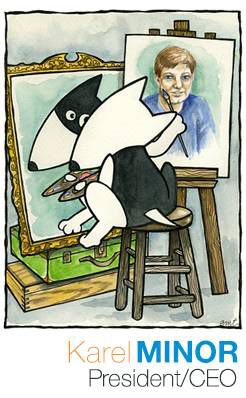(As promised in the 2018 State of Humane PA post, I’m posting a series of more detailed weekly follow ups on the bullet point list provided there. Keep checking back or subscribe to the feed to get updates!)
2017 was one of the best years for animals in the 117 year history of Humane Pennsylvania (and Humane Society of Berks County and Humane League of Lancaster County). Using modified Asilomar reporting, we had a success rate- out alive- of 97% for dogs, 94% for cats, and 100% for small animals! That’s as good as we’ve ever done for dogs and small animals, and better than we’ve ever done for cats.
But it was (probably) Mark Twain who said, there are lies, damned lies, and statistics. Anyone who claims stats like that better be prepared to defend them. And I’m just the anyone to do it. After all, how can we say we saved 94% or more of animals when 1,092 of the 4,642 animals who entered our shelters didn’t leave us alive?
First, I better explain what we mean by “modified Asilomar” reporting. Asilomar reporting is the closest thing to an industry standard as there is for reporting intake and outgoing figures in shelters. Using Asilomar, a shelter establishes four categories of animals. Healthy & Adoptable, which as the name implies, means happy, healthy animals. Treatable, which is further broken down into Rehabilitatable (can be made Healthy) or Manageable (has a chronic issue such as diabetes or manageable behavioral issue). The last group are the ones determined by community standards to be deemed Unadoptable. We are very by the book about what makes it to these groups and you can read our detailed matrix for deciding here. Our reporting is modified because we are a bit stricter in our interpretations and designations than Asilomar allows for (for example, ASPCA says that animals under eight weeks (!!!) can be deemed unadoptable under Asilomar. That is batsh*t crazy talk).
Where shelters get into trouble is often to shove everything into the “unadoptable” group, but we are very transparent about our thinking and reporting. If an animal is Treatable, even up to the point of pretty heroic measures, we put it in Treatable. The animals that go into Untreatable are animals that either are obvious (you’ll see what I mean in a second) or animals which reasonably belong there. For example, of the 1,092 animals which are reported as “failures”- i.e. they didn’t leave alive- 609 of them (56%) came to us already dead for disposal or cremation (139), so injured that they actually died under veterinary treatment (50), or were brought to us by their owners specifically to be euthanized for valid reasons (420). Most reasonable people would grant us that these are animals which we shouldn’t count against our adoption numbers, because they had no chance of being adopted. We can’t raise the dead. Yet.
Of course, it goes without saying but I will say it anyway, we don’t euthanize any happy, healthy animals and we haven’t since 2008. Let me repeat that: all healthy animals get adopted. Full stop.
But that’s a lot of ground in between those two groups, fully 483 animals or about 10% of our intake. Those last 483 are the ones we struggle with, some more than others. A small number (6) run afoul of state rabies regulations and have wounds of unknown origin that require a level of quarantine we can’t provide. Some animals (10) come in with such a history of serious bites we don’t even consider adopting them. Some feral cats (10) were euthanized this year because we can’t safely house them and we didn’t have an alternative rescue placement, despite our extensive partnerships with feral cat networks. When I started 13 years ago we euthanized 1,000 feral cats a year. A 99% decrease isn’t perfect, but it’s pretty close. 3 dogs came in that were so old it wasn’t humane to keep them. 14 extremely young kittens were euthanized, also drastically lower than past years because we have pioneered giving a kitten nursing kit to people for free. Thanks to this program we saved 90 kittens who came to us that went home with finders or fosters. 23 animals that came were euthanized because of serious bites to humans, either in the community or in our shelters, and fell into the rabies concern issue, as well as safety concerns. 1 cat escaped. 98 animals were euthanized for aggression that rose to a level that made our staff and managers decide that there was not a safe placement option. Animals which we would fear to have in our homes with our families should not be at home with your family.
These are all animals which did not leave us alive. But each of them was considered individually, treated with compassion, and ultimately it was the most appropriate decision for each of them. I will be honest when I say bluntly, these are not the ones I lose sleep over.
The ones which I lose sleep over are the ones in two groups: animals euthanized for behavioral issues and sick animals. These are our clearest failures and the ones in which we always second guess ourselves. If we had more resources, more staff, more time, more space, more, more, more…could we have saved them? There were 88 animals with such severe behavioral issues that we were unable to find an adopter or did not feel it was best for the animals to languish in a shelter, never adopted. 131 animals were euthanized that came to us profoundly sick but not terminally ill, and 86 became ill while in our care and were euthanized. To be fair, we used to kill thousands of animals just because they sneezed, so this number is a victory by comparison. But if you ask those animals, they won’t pin a ribbon on us.
These are the toughest failures because we have gotten so good at saving animals. We are now the go-to shelter for animals with major problems. That makes it harder and more expensive than ever, and while we do better than ever, we don’t succeed every time. We do literally everything in the playbook. Hell, we wrote the playbook for many of these programs. We were the first nationally recognized organization to pioneer free adoption programs as standard practice. We have been groundbreaking in our veterinary services to the shelter animals and the community. We work aggressively with rescue groups. We don’t block adoptions for stupid reasons. We do everything in our power to get these animals out alive.
When I started 13 years ago we took in 7,000 animals and we killed about 4,000, excluding dead animals and owner requested euthanasia. Now we take in 4,649 and we kill about 400 treatable animals, albeit profoundly sick or behaviorally compromised. If they weren’t real lives, this would be level of success that we would never shut up about. But for those 400, our best year ever was still a failure. Sorry to be a Debbie Downer about it, but it’s true. Our staff is second to none. This year’s success was second to none. You, our supporters, are second to none. But it still wasn’t enough. It wasn’t perfect.
I apologize to you and to every single animal we could not save for not being perfect, even if that’s not realistic. And that’s why we have big plans for this year. We can bring these number down even more, we can finally say we can achieve a “target zero” without being utter liars.
We’ve never done better, but that doesn’t mean we aren’t going to try like hell.




